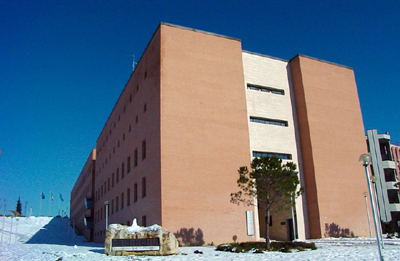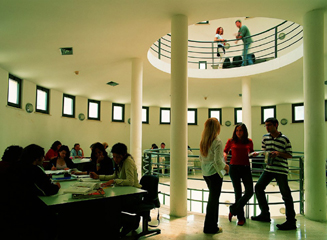
The ‘G. d'Annunzio’ University is divided into 13 Departments, which are primary centres where teaching and research co-exist to promote the scientific activities of the different educational areas. Two or more Departments that are grouped according to their particular affinities work as connecting structures, for the coordination and rationalisation of their teaching activities, and these are referred to as the University Schools.
 Department of Pharmacy
Department of Pharmacy
• The School of Medicine and Health Sciences
Department of Medicine and the Science of Aging
Department of Neuroscience, Imaging and Clinical Sciences
Department of Psychology, Health and Territory Sciences
Department of Medical, Oral and Biotechnological Sciences
• The School of Economics, Business, Law and Sociological Sciences
Department of Economics
Department of Law and Social Sciences
Department of Architecture
Department of Business Economics
Department of Pharmacy
Department of Engineering and Geology
Department of Literature, the Arts and Social Sciences
Department of Languages, Literature and Modern Cultures
Department of Philosophical, Pedagogical and Quantitative Economics Sciences
Centres and Schools of Advanced Studies
The ‘G. d'Annunzio’ University also has cross-departmental research, which is characterised by interdisciplinary and international vocations. These centres combine scientific research and education in a setting of high specialisation and quality. The University also includes the Centre for Research into Aging (CeSI), the CeSI Biotech Department, the Clinical Research Centre (CRC), and the Institute of Advanced Biomedical Technologies (ITAB), which was set up through the European Union. The University also has a University Language Centre (CLA).
The University established the ‘Gabriele d'Annunzio’ School of Advanced Studies, which is aimed at the internationalisation and advanced education in research. It makes use of the Commission for the Evaluation of Research and Technology Transfer (CVRTT).
Libraries and museums

The library centres consist of the subject libraries, interdisciplinary libraries, and the libraries foundeed on the two University sites of Chieti and Pescara. The structures and the library document services of the University provide support services to students, lecturers and technical-administrative staff. Within the Chieti campus, there is the Medical-Scientific Library and the ‘Ettore Paratore’ Inter-Faculty Library. The University in Pescara hosts the Unified Library.
The digital library of the University collects and manages the electronic bibliographic resources, which are purchased either centrally or individually, and makes them accessible to users. It also offers a selection of scientific journals that are published by the Departments and the research groups of the ‘G. d'Annunzio’ University.
The University offers a wide range of collections, which over time have been enriched and organised in the University Museum. The Museum is affiliated to the International Council of Museums, and from the moment of its establishment, it also participated in the Permanent Conference of University Museums associated with the Conference of the Rectors of Italian Universities (CRUI).
The Faculty of Literature and Philosophy
 The Faculty of Literature and Philosophy was ‘born’ in a museum, and it was the first nucleus of the free courses initiated in Chieti by the University Consortium of Abruzzo, which was established by the local authorities and other institutions for the development of higher education. In the autumn of 1961, it was the National Archaeological Museum itself that hosted the first courses. To initiate these courses, the University Consortium of Abruzzo relied on the illustrious exponents of the Italian Academia, and thus constituted a Technical Committee with the task of organising the teaching (e.g., study programmes, lecture times) and assigning the teaching to lecturers. This Committee included Prof Ettore Paratore, full Professor of Latin Literature at the University of Rome, who took up the position of President, Prof Carlo Grabher, full Professor of Italian literature at the University of Perugia, and Prof Joseph Schiro, full Professor of Byzantine Philology at the University of Rome, who acted as secretary. For the first year of studies, 16 subjects were defined, and classes began on 13 November, 1961. The students who are registered for the Literature university courses are now numerous. It was not until the 1964-65 academic year that the first students were enrolled onto the graduate programme in Philosophy.
The Faculty of Literature and Philosophy was ‘born’ in a museum, and it was the first nucleus of the free courses initiated in Chieti by the University Consortium of Abruzzo, which was established by the local authorities and other institutions for the development of higher education. In the autumn of 1961, it was the National Archaeological Museum itself that hosted the first courses. To initiate these courses, the University Consortium of Abruzzo relied on the illustrious exponents of the Italian Academia, and thus constituted a Technical Committee with the task of organising the teaching (e.g., study programmes, lecture times) and assigning the teaching to lecturers. This Committee included Prof Ettore Paratore, full Professor of Latin Literature at the University of Rome, who took up the position of President, Prof Carlo Grabher, full Professor of Italian literature at the University of Perugia, and Prof Joseph Schiro, full Professor of Byzantine Philology at the University of Rome, who acted as secretary. For the first year of studies, 16 subjects were defined, and classes began on 13 November, 1961. The students who are registered for the Literature university courses are now numerous. It was not until the 1964-65 academic year that the first students were enrolled onto the graduate programme in Philosophy.
The Faculty of Business and Economics
The need to establish a University Faculty in Pescara was proposed in the 1960s by the President of the Provincial Administration, Prof Giovanni Iannucci. Between October and November 1961, enrolment for the courses of the Faculty of Business and Economics, with the adjoining Foreign Languages and Literature, were officially opened. The response of young people and families of Abruzzo was immediate, and also those of the neighbouring regions, such as Marche and Molise. For the first academic year in 1961-62, there were already 638 registrations, which were mainly for the Business and Economics courses, as can be seen from the archives of the present ‘G. d'Annunzio’ University. The success of the Pescara courses can be explained for more strictly academic reasons, as for example the reputation and prestige of the first lecturers who carried out the teaching activities.
The Faculty of Foreign Languages and Literature
 In the academic year of 1961-62 the degree course in Foreign Languages and Literature was established within the Faculty of Economics and Business. The courses were later transformed into a Faculty, in the academic year 1971-72. With the establishment of these new courses and the promise of a new Faculty, the Free University of Abruzzo saw the doubling of its facilities in only a few years. From the 638 students who were enrolled in the Faculty of Economics and Business and in the Languages course in the academic year 1961-62, these reached 6,000 in the academic year 1990-91.
In the academic year of 1961-62 the degree course in Foreign Languages and Literature was established within the Faculty of Economics and Business. The courses were later transformed into a Faculty, in the academic year 1971-72. With the establishment of these new courses and the promise of a new Faculty, the Free University of Abruzzo saw the doubling of its facilities in only a few years. From the 638 students who were enrolled in the Faculty of Economics and Business and in the Languages course in the academic year 1961-62, these reached 6,000 in the academic year 1990-91.
The Faculty of Medicine and Surgery

The official ‘birth’ of the Faculty of Medicine of the ‘G. d'Annunzio’ Free University has been defined as 11 November, 1966. On this day in the Meetings Hall of the Inter-Province University Consortium, which had been established between the provinces of Chieti, Pescara and Teramo and their municipalities in 1964, the President, Antonio Mancini, detailed the proposal for the establishment of the Faculty of Medicine to the Consortium Assembly. This proposal had been drawn up by the Board of Directors of the University, which had been established in 1965.
A search for lecturers from various Faculties was performed carefully, and as well as providing cultural enrichment, this laid the foundations for the subsequent decision-making autonomy. Moreover, a balanced and careful set of actions was started that was aimed at the integration of the Faculty into the social fabric, and that drove forward the progressive and harmonious fusion of the university components with those of the hospital. Numerous Schools of Specialisation were established, a Convention between the Hospital and University was drawn up, and the first research facilities were developed.
In 1987, the degree course in Orthodontology was ‘born’, and the number of Schools of Specialisation was increased. In 1988, Prof Franco Cuccurullo, the Professor of Medical Pathology and Clinical Methodology, was appointed as Chairman of the Technical Committee. Prof Cuccurullo guided the Faculty with extensive collaborations with many colleagues, and promoted and facilitated the formation of links with various European and North America University Schools. He also gave broad support to all scientific and cultural initiatives that provided prestige to the Faculty, and reorganized the operation of the old and new bodies of the Faculty on a rational basis. With the Presidency of Prof Cuccurullo there also came ‘Cosmos’, the first newspaper of the Faculty, and the Ethics Committee for Biomedical Research was founded.
The Faculty of Architecture

The Faculty of Architecture of Pescara was officially ‘born’ on 1 September 1, 1967, on the day when Franco Iossa, who was President of the Faculty of Architecture of Naples and full Professor of Structural Mechanics at the same Faculty, accepted the appointment as Technical Commissioner of the Consortium for the ‘G. d'Annunzio’ Free University of Abruzzo, for the establishment of a Faculty of Architecture in the Abruzzo city of Pescara.
In the academic year 1973-74, the Faculty Council decided to adopt a set of operating rules. In the initial phase, the teaching activities of the Faculty took place according to a special programme of studies, which was developed by the Technical Committee and approved by the Consortium. All of the new trends that were emerging while organising this study programme for the Faculty of Architecture were taken into consideration. This led to the identification of three different, but parallel, approaches in the architectural discipline that led to a single result of high cultural value, through this tackling of the problem from multiple points of view. These three approaches are embodied as the design, historical and scientific disciplines.
Presidential Decree 09/03/70 N° 441 provided for official recognition of the Faculty of Architecture of Pescara only for an initial 2 year period. Then Presidential Decree 30/10/71 N° 1317 extended the recognition to a 5-year period, and specified the study structure as including 16 fundamental subjects and 14 complementary subjects, to be taken in the relevant order.